Greetings
This is the first installment in the creation of the new book by Seba MAA entitled Mysteries of the Kybalion.
This is a pilot program to present a new book project online while allowing aspirants to partake in the process beyond acquiring the book when the editing process is completed. Here you will have an opportunity to read the text and formulate questions and have them answered. You will be able to partake with other aspirants and learn from their questions and through fellowship with them as you all study the text together. Additionally, this is not the final version of the book so one should not expect final typesetting, spelling or grammar in this presentation and there will be changes before the final version is published in physical form. This presentation is for early sharing of a manuscript and for sharing the essence of wisdom, the maut or take away from the teaching of the text, which will undoubtedly provide more insights as the project moves forward and even after the final physical book is produced. Some questions and answers may appear in the final physical book. Another benefit of this project is that you will be able to spend quality time with the web site as well which constitutes khnumt nefer-good association.
There will be weekly postings and the first week contains the Forward and Introduction, which will provide a important foundation and background for the rest of the text.
HTP
FOREWORD
This Volume is divided into two sections. Part 1 INTRODUCTION presents a brief history of Hermeticism, its origins in the Ancient Egyptian Mysteries (Neterianism) the Kybalion and the origins of the personality known as Hermes Trismegistus. Part 2 presents the essential teachings of the Kybalion text, a set of MAXIMS, without interpretation. Part 3 presents glosses (commentary and explanation) on the essential teachings of the Kybalion based on the philosophy of the Ancient Egyptian Mysteries as determined by Sebai Dr. Muata Ashby based on studies and translations of original Ancient Egyptian Hieroglyphic texts; the source from which the Kybalion teaching is derived. The Glosses are an edited version of Lessons given by Sebai Dr. Muata Ashby in the form of lectures on the teachings of the Kybalion.
PART 1: A Brief History of the Kybalion
INTRODUCTION
“The principles of truth are seven, he who knows these, understandingly, possesses the Magic Key before whose touch all the Doors of the Temple fly open.”
About The Kybalion: Hermetic Philosophy
The Kybalion: Hermetic Philosophy is a 1908 book, published by the Yogi Publication Society, purporting to be the essential teachings of Hermes Trismegistus. It was published anonymously by either a group or a person under the pseudonym of “the Three Initiates”. Hermes Trismegistus (Ancient Greek: Ἑρμῆς ὁ Τρισμέγιστος, “thrice-greatest Hermes”; Latin: Mercurius ter Maximus) is the purported author of the Hermetic Corpus, (Corpus Hermeticum) which are a series of sacred texts that form the basis of Hermeticism. In Islam, during the first centuries after the creation of Islam, the Hermetic “cult” was accepted as being the Sabians mentioned in the Qu’ran in 830 CE. (Churton pp. 26-7).
Image HermesTrismegistus from the middle ages or renaissance
Image: Hermes Trismegistus, floor mosaic in the Cathedral of Siena (c. 1480s)
TEXT:
Take the letters and the laws of the Egyptians, right on the stove, which kept a sphinx // God, the creator of all things, with God himself created the visible and created the first and only person who was glad, and very loved his own son, who is called the Holy Word
About The Hermetica
The Hermetica (or Hermetic literature) are Egyptian-Greek wisdom texts that date back to the 2nd and 3rd centuries CE. These texts are most often presented in the form of dialogues in which a teacher, who is generally identified as Hermes Trismegistus, enlightens a disciple through the Hermetic wisdom teaching. The texts form the basis of Hermeticism. They discuss the cosmos, the divine, nature and mind so as to lead the listener, the disciple, to attain higher consciousness, to discover the higher order of being which is a mystic self-realization, the coveted goal of all mysteries systems and mystical philosophies of the world, transcendental enlightened consciousness.
About The Term Trismegistus or “thrice great”.
A view of the The Temple of Esna in 2004.
Copenhaver reports that this name is first found in the minutes of a meeting of the council of the Ibis cult, held in 172 BCE near Memphis in Egypt. Another explanation is that the name is derived from an epithet of Thoth found at the Temple of Esna, “Thoth the great, the great, the great.” Muata Ashby identified the Ancient Egyptian hieroglyphic text from which the term is derived and is presented below.
“Djehuty aah-u” is an ancient Egyptian hieroglyphic title of the god Djehuty. It means “three times great.” This same title in the Ancient Egyptian language makes use of the glyph which means “great.” The use of three glyphs can be taken to mean three or plural. The same term appears in the Hermetic period of Greek culture in association with Ancient Egypt in the term Hermes Thrice Greatest. Hermes is the Greek name for the Ancient Egyptian god Djehuty. Therefore, the ancient tradition in the form of the title was transferred into Greek philosophy during the late period of Ancient Egyptian history and the post-classical period of Greek history.
The Ancient Egyptian God Djehuty
Below: Image of the god Djehuty fulfilling one of his main roles as the recorder of the result of the balance of the human heart against the feather of Maat. [from the Papyrus of Ani]
Hermetic Texts found in Egypt
Sir W. Flinders Petrie places the Hermetic texts between 200 and 500 BCE. (Abel and Hare p. 7) Plutarch’s mention of Hermes Trismegistus dates back to the first century CE (1-100 CE). In 1945 CE, Hermetic writings were among those found near Nag Hammadi, Egypt in the form of one of the conversations between Hermes and Asclepius from the Corpus Hermeticum, and a text about the Hermetic mystery schools, On the Ogdoad and Ennead, which was written in the Coptic language. Coptic is the last form in which the Egyptian language was written (Way of Hermes, pp. 9-10). The concepts discussed within the Corpus Hermeticum are distinctly ancient Egyptian. This includes the concept, “All is one, all is from the One” (Way of Hermes, pp. 10). Additionally, the concept of an “ogdoad” is also directly derived from Ancient Egyptian cosmology.
The following excerpt comes from the Hermetic Gnostic Ancient Egyptian text known as Asclepius from the group of texts known as the Nag Hammadi Library that was found in Nag Hammadi Egypt.
Do you not know, Asclepius, that Egypt is the image of heaven? Moreover, it is the dwelling place of heaven and all the forces that are in heaven. If it is proper for us to speak the truth, our land is the temple of the world. But you should know that a time will come when Egyptians will seem to have served the divinity in vain, and all their activity in their religion will be despised. For all divinity will leave Egypt and flee upward to heaven. And Egypt will be widowed; it will be abandoned by the gods. For foreigners will come into Egypt, and they will rule it.
—Asclepius, Nag Hammadi Library
Finally, the Kybalion is an ancient text from the Hermetic period of ancient Egyptian Philosophy, ancient Kemetian Philosophy. This is a period when the Mystery schools and temples of Ancient Egypt were still in operation, though in decline. It is the period where, the ancient Greek students of the great temples of Kemet, such as Plutarch, had adopted the teaching, that was given to them by the Ancient Egyptian priests and priestesses and they were associated with the ancient Egyptian temples; these are not the students or the people who later took the Ancient Egyptian principles and changed them; rather these are the ancient Greek people who received them from the source and studied them and tried to promote the original teaching. Therefore, whether we are looking at texts that were written during the Hermetic period (c. 600 BCE-300ACE) or by subsequent writers who are following the teaching of those texts, we are ultimately studying Ancient Egyptian philosophy which came to be called Hermetic Philosophy even as it might have had some elements of Greek religion or philosophy added to it. This issue was confronted by the sage Iambluchus (Greek name) also known as Ab Amun (Egyptian name) in his monumental work called On the Mysteries, where he identifies such elements and sets the correct parameters for understanding Ancient Egyptian Philosophy apart from the extraneous and or misconceived notions from other traditions that all existed at the same time especially in Greek culture.
This philosophy is also called Hermeticism, but the term Hermeticism or Hermetics is derived from the name Hermes and as you well know, as we have already noted, the personality Hermes, the God Hermes, is the name that the ancient Greeks gave to the ancient Egyptian God Djehuty. So the Greeks and the Romans adopted these teachings. This is before Christianity. During the late period of ancient Egyptian history, Hermeticism began to develop after the first Greek philosophers, such as Pythagoras, Socrates, Plato, Thales, Eudocius and others, began to study in the temples and bring the teaching back to Greece.
So we are talking about a period in history between the years 600 B.C.E and 100 B.C.E. It is a period where the teachings were already in place in Kemet 5000 B.C.E or earlier. They began to be intellectually espoused, by the Greek students and the seven Hermetic principles, are the distillation of those. Throughout this volume we will discuss the principles. But before we discuss the first principle of the Kybalion, first we should know a little about the God Djehuty. Djehuty is a son of Ra, part of the Anunian tradition of Neterianism, Shetaut Neter religion, the religion of ancient Egypt. And as you know, all of the Gods and Goddeses of Kemet, they have a special teaching related to them, they represent principles; and some were accorded so much respect and honor, that they became the divinity of a particular city and particular scriptures were developed around them. So Hermeticism is a particular scripture related to the God which the Greeks called Hermes (also known as Thoth) which was also the name they gave to the Ancient Egyptian God Djehuty (or Djehuty). But speaking about the ancient Djehuty, from which Hermes is derived.
Ancient Egyptian Anunian Tradition and the Position of Djehuty
One more item is important to be understood in order to comprehend the deep background of Hermeticism originating in Ancient Egypt. Where does Djehuty fit into Ancient Egyptian religion? Ancient Egyptian religion or what is also referred to as the Ancient Egyptian mysteries, is actually a collection of related traditions (mythic, ritual and philosophical) that had the same origin, Anunian Theurgy, and which coexisted in the same country; sometimes in operation at the same time and at others, over a time span of more than 5,000 years, some operating more prominently than others. Yet none was repudiated or in competition with the others since all were understood to be manifestations of the same teaching as rendered by the priest/esshood of the particular tradition at a particular time in history. Therefore, they were complementary.
Ra may be seen as the Soul of Creation and Djehuty may be seen as the Cosmic Mind of Creation. Additionally, Djehuty is the wielder of the Caduceus and master of the Serpent Power, the discipline referred to as Kundalini Yoga in India; Creator of the Hieroglyphic writing [Medtu Neter]; Recorder of the teaching (the Sebait, the Ancient Egyptian mystery philosophy) he received directly from God Khepri, the Creator (a form of Ra). Khemenu Theurgy, which relates to the wisdom and teaching of the God Djehuty, later gave rise to Hermeticism.
In the Ancient Egyptian Creation tradition, Djehuty acted as the scribe of the Creator, Khepri. In his capacity he codified the wisdom that was told to him about the nature of Creation and the wisdom of existence.
Above: Lord Khepri brings creation into being by lying down on the primeval ocean and causing the great primeval serpent, ashra hrau to churn the ocean. Then the divinity of the primeval ocean, Nun, raises the boat of Khepri so that it may begin a journey of millions and millions of years so as to maintain Creation.
After Khepri brought Creation into being then Khepri in the form of Ra Hrakhty sustained that Creation and then brought forth nine gods and goddesses that constitute the elements of Creation as well as the elements of the personality. The image below illustrates the main divinities of Anunian Theurgy as well as their relationships.
The image above shows the main gods and goddesses of the Anunian Tradition of Ancient Egypt. Djehuty represents purified intellect and the reflection of god consciousness (Ra’s mind). For more see the book African Religion Vol 1 Anunian Theology.
The God Djehuty and the Company of Gods and Goddesses of Khemenu
Pauti Khmn Anu
“Company of Eight Gods and Goddesses of Anu”
The term Khemenu, or city of the eight, relates to the city where the worship, reverence and teaching of Djehuty was recognized as primary. The Ancient Egyptian Greeks called this same city Hermopolis (Greek: Ἑρμοῦ πόλις μεγάλη ) [Hermo (about Hermes) and Polis (city)] after their name for Djehuty which was Hermes.
The God Djehuty and the Company of Gods and Goddesses of Khemenu are related to Anunian Theology. Therefore, they are to be viewed as an adjunct tradition in the same way as the Asarian Tradition although the Khemenu Tradition was not as popular as the Asarian Tradition or the Anunian until the late period of Kamitan/Kemetic history. Firstly, the god Djehuty along with the goddess Maat deserve a special place of prominence because they emerged along with Ra in his Divine Boat of Creation the first time he surfaced out of the Primeval Waters.

Eye of Djehuty (left eye, lunar)
Secondly, Djehuty is referred to as the “heart and tongue of Ra.” This means that he was the mind (intellect) and mouthpiece (performer of actions) of Ra, so he was Ra’s viceroy and minister. He transmitted to the world of time and space, the desires of Ra and carried out his bidding on earth. He is therefore regarded as the Lord of Words and the Wheigher of Words in the great Hall of Maati where the heart of the deceased is weighed against the standard, the feather of Maat (right and truth).
The city Khmnu (city of the eight) became the seat of the worship of Djehuty and the Company of Eight Gods and Goddesses of Anu became the Company of Djehuty. Djehuty had a Divine Boat wherein he sat, a man with the head of an Ibis bird , with a Crescent Moon headdress, along with his second popular form of manifestation, the baboon. (see below) The Baboon form is often seen offering the left eye of Heru, (which is the same left eye of Ra). He is also known as the “Healer of the Eye” and the “Pacifier” of the combatants, i.e. Heru and Set. One more important quality of Djehuty is that he is the controller of the caduceus, the staff with two serpents which is the “Staff of Life” or wand that promotes spiritual awakening.
Below: The Ancient Egyptian god Djehuty holds the caduceus (from the Temple of Seti I, Abdu, Egypt).
The two aforementioned forms of Djehuty are composite (ibis headed man), or zoomorphic (baboon). Djehuty has an anthropomorphic form, Yaah-Djehuty. In this form he is the god of the moon, i.e. the mind. In this form he appears as a mummy bearing the crescent moon (increasing intellect) on his head, and holds the symbols, nekaku -flail (discipline and command), heka-shepherd’s crook (royalty-leadership), djed (Asarian higher consciousness), ankh (life force), uas -capacity to allow the living higher consciousness to flow), hensekti, side lock (youth), menat (female creative power).
Djehuty is the symbol of right reason, the link to the Higher Self. When the determination to pursue the Divine arises, the struggle becomes a holy war against ignorance and illusion within one’s consciousness. If this process is not understood as a struggle to overcome anger, hatred, greed, bigotry, jealousy, etc., within one’s self, the energy of the struggle becomes directed to the world outside of oneself in the form of political, religious, social, ethnic, gender, etc., conflicts.
In the Ancient Egyptian myth of the Asarian Resurrection, Lord Djehuty plays a pivotal role in facilitating the upbringing of Heru and his ultimate victory against the unrighteous Set. The struggle between Heru (higher self) and Set (lower self) does not end with either destroying the other. Heru pursues the path of reason seeking counsel with the wisdom of Djehuty. Wisdom follows the exercise of reasoning in peace, and reason follows the practice of studying, questioning, reflecting and inquiring into the nature of truth. In Neterian myth Set, the lower self, refuses to abide by the decree of wisdom but he is eventually sublimated through his own humiliation and ignorance. In the end, when the aspirant is aligned with all the divine forces, the lower self can no longer struggle. The overwhelming force of the Divine pushes the lower self into a position of service rather than of mastership; this is its rightful place.
Two of Djehuty’s most important titles are , “Djehuty Thrice Great,” and , “Lord of the words of power.” The Greek-Hermetic philosophers of the time period between 300 B.C.E. and 500 A.C.E. adopted the title “Hermes Thrice Greatest” as the name for the originator of the Hermetic teachings, thus openly acknowledging their Kamitan (African) origins.

Above: from papyrus Nebseni, the oldest known rendition of Djehuty depicted as a baboon watching the balance of the heart.

The God Djehuty has two principal forms of manifestation, the Ibis and the Baboon. Both of these animals symbolize intelligence and perseverance. The Ibis with its long beak can feel deep into the muddy waters to discover tasty morsels-symbolizing acute intellectual capacity to see through the mucky and murky waters of life and time and space in order to grasp fragments of truth that brighten the intelligence.
The baboon is intelligent but also meek. In the myth of Hetheru and Djehuty, He acted as her spiritual preceptor and came to her in the form of a baboon to teach her the wisdom that leads to spiritual freedom and awakening. Baboons are known to have been well trained in Ancient Egypt. They performed many tasks like harvesting fruits for farmers and even clearing off tables at restaurants. In the form of a baboon, Djehuty fixes the eye of Ra, i.e. Hetheru (Hetheru and the right eye of Ra are identical). Thereby she became enlightened and freed from all sorrows and ignorance.
Djehuty And the Hermetic Philosophy
Djehuty, as Lord of Words of Power was also known by the Ancient Egyptians as “Djehuty Lord of Divine Words” and was known as the creator of Medtu Neter (Ancient Egyptian hieroglyphic writing). As such he is the supreme exponent of the philosophy of the Shetaut Neter and thus he is said to have written the books of the Pertmheru himself with his fingers and his beak (as his pen). According to Clement Alexandrinus in his Stromata VI, Hermes (Djehuty) was also the author of 42 books dealing with laws, gods and goddesses, education of the priests and priestesses, worship and services of the gods and goddesses (sacrifices, offerings, etc.), history, geography and hieroglyphs, astronomy and astrology, religious compositions and medical science.
In the very late period of Ancient Kamitan history, when the Greeks conquered Egypt, the Greek philosophers began to study and translate the Ancient Egyptian texts and a new genre of literature that was ascribed to Hermes, whom they equated with Djehuty, was commenced. The ancient Egyptian term Djehuty aahu- literally “Djehuty three times great” became “Thrice Greatest Hermes” to the Greeks of the Hermetic period. Though a compilation, authored by Djehuty, labeled as 42, besides the 42 precepts of Maat in the Pert M Heru (Ancient Egyptian Book of the Dead [Book of Enlightenment]) has not been discovered, the writings of the “Hermetic Texts” coupled with the earlier hieroglyphic medtu neter texts certainly cover the range of subjects mentioned by Clement.
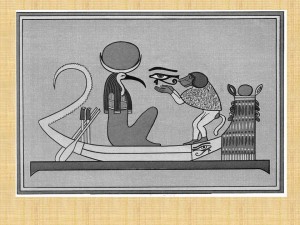
Above: Divine boat of Djehuty.
As all other major divinities Djehuty has a Divine Boat. In this boat he moves through Creation establishing the teachings he codified in the Medtu Neter.
As a character in the mysteries, the priests who reenacted the part of Djehuty in the practice of the Temple rituals (Divine Plays) used a mask in order to enhance the experience of adopting the character, feeling and wisdom of Djehuty.
Khemenu Theurgy and The Ogdoad of Djehuty
In Theban Theurgy, in the form of Kamutf, the God Amun brought the Creation into existence along with and through eight divinities, each symbolizing one of eight complementary (male-female) cosmic principles of Creation, i.e. the opposites of Creation. These divinities were later regarded as the Ogdoad. This scheme or matrix for Creation (cosmology) also was used in the city known as “Khemnu” or “City of the eight.” The gods and goddesses of the ogdoad were:
In later times the position as the head of the Ogdoad was given to the god Djehuty due to his popularity in the city of Khemenu. Note here that the Ogdoad of Amun is a reworking of the Ogdoad of Ptah. So this same teaching is carried forth through the main Ancient Egyptian traditions. Again, this constitutes another Correlative Theological Statement, which links the Neterian traditions, once again showing that behind the apparent multiplicity and variation there is a calculated pantheism underlying the mythic systems that reflects the fundamental teachings and principles in seemingly different divinities.
Below: the God Djehuty (far right) gives life-breath to Asar (far left).

Temple of Asar, Lord Djehuty holds the Caduceus in is left hand and gives life to Asar with the Ankh in his right hand
Below-left: the Greek God Hermes holding the Caduceus-compared to the image of Djehuty

Below: Aesculapius, the Greek god of medicine. Right- Caduceus of Aesculapius.

The Book of Djehuty
One of the most important texts of Khemenu Theurgy is the Book of Djehuty. This text covers the wisdom of the Serpent Power and the nature of Creation that is attained when Higher transcendental consciousness is achieved. Many allusions have been made to a special book of Hermes, in later Hermetic history. One such book is referred to the “Emerald Tablet” However, the Ancient Egyptian Book of Djehuty fulfils all of the mystic expectations of a high mystic tradition and it is accessible for the avid follower of the mysteries. This teaching is covered in the book The Serpent Power.

Setna Reads the Book of Djehuty
15. And he went to the deathless snake, and fought with him, and killed him; but he came to life again, and took a new form. He then fought again with him a second time; but he came to life again, and took a third form. He then cut him in two parts, and put sand between the parts, that he should not appear again.
The Ancient Egyptian Djehuty as preceptor and prototype of the Greek Hermes
Below: – Djehuty restoring to Hetheru the Udjat (Uatchit) Eye, ^, which had become blinded by ignorance.
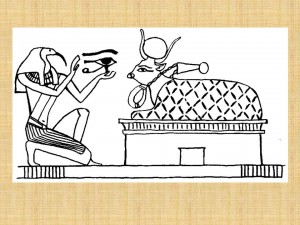
Below: -Djehuty restoring to Heru the Udjat (Uatchit) Eye, _, which Set (egoism) had blinded.

In Ancient Egyptian mythology, Djehuty is the divinity that most perfectly fills the role of spiritual preceptor in the form that is later present in the Greek Mysteries and in Hermeticism. He is a mystic physician as he heals the eyes of intuitional vision, i.e. through his teaching he cleanses ignorance and enables a disciple to attain higher consciousness and spiritual enlightenment.
Djehuty is the spiritual preceptor of two important Kamitan Divinities, Hetheru and Heru. He fixes their faulty vision, i.e., he enlightens their intellect in the myth of the Divine Cow (also known as the Story of Hetheru and Djehuty) and the myth of the Asarian Resurrection. The picture above-left is from the latter myth, where Djehuty repairs the higher vision of Heru, that was damaged by Set, the ego consciousness. In this manner, the aspirant should allow {himself/herself} to be enlightened by the teaching. In this manner the Serpent Power becomes effective and powerful.











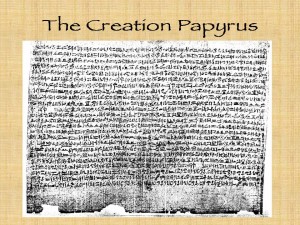



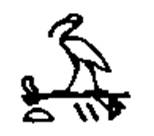

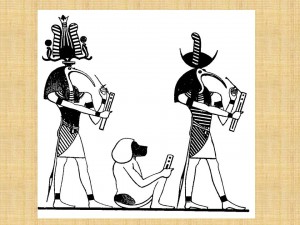





10 comments for “New Book Project Mysteries of the Kybalion -Part 1 Online now”